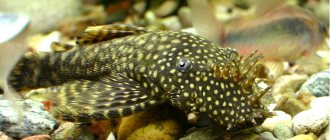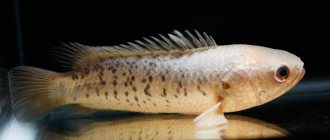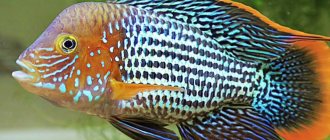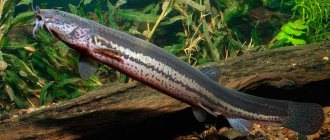5
(5)
Viviparous fish occupy a special place in the world of aquariums. Often these include unpretentious fish that can survive even with novice aquarists who are unable to provide the necessary conditions.
One of the most popular of these fish is the black molly. Of course, its name is familiar to many people. However, breeders have been developing new varieties and color variations for decades. One of these is the black form. It looks very interesting and is immediately memorable, since you rarely see fish that have a jet-black body color.
Mollies
Those wishing to have a black aquarium fish should first of all pay attention to mollies. These viviparous fish from the Poeciliidae family are unpretentious and suitable for beginner aquarists. They are distinguished by their relatively large sizes (up to 10 cm) and deep black color without interspersed with other colors.
Mollies are kept in a flock of 7 or more individuals; the group should be dominated by females. The minimum aquarium volume for these fish is 50 liters. Mollies prefer a temperature of 23-28°C, pH 7-8 and dH 10-20°. The species does not like sharp fluctuations in water temperature, excess nitrogen compounds and lack of oxygen.
Exotic aquarium fish, photos with names
Among those fish that were mentioned above, there were a lot of exotic fish. But these are not all the strange fish that you can keep right at home today. Here are the names and photos of the most beautiful and unusual exotic aquarium fish:
Elephant fish
glass perch
Tetraodons or four-teeth
Macrognath
Silver arowana (dragon fish)
Skat Motoro
Red-bellied Piranha
Mastocembelus redstripe
Mastocembelus armatus armored
Botia marble
Fish knife Khitala
Leporin tape
Arabian butterfly fish
Tamarin yellow
Florida armored pike
Surgeon olive
Chromis
Royal Gramma
Gramma blackhead
Queen Nyasa
Falsechromis violet
Falsechromis Friedman
Fundulopanax
Heufrich's Nemateleotris
Bleeker's Parrotfish
Green clown goby
Gymnothorax funebris or green moray eel
Snipe wrasse
Bristle-tailed unicorn
Rose-tailed Triggerfish
Thalassoma lunarum
Green tamarin
Acantophthalmus
Black angelfish
Black angelfish is a color variation of the common angelfish obtained as a result of selection, differing from the natural form in its completely black color. These fish reach a length of 15 cm, and their fin span can be up to 25 cm.
Angelfish are kept in pairs or small groups in containers with a volume of 100 liters per pair of individuals. This species prefers a temperature of 24-26°C, pH 6.5-7.5 and dH 5-15°. The aquarium should have enough free space for swimming. Angelfish tolerate bright light well, so any plants can be planted in the aquarium. Angelfish are peaceful, but can eat fry and small fish.
Diseases
Disease-resistant immunity. Pets tolerate gradual changes in maintenance well.
Under stressful conditions, the color loses intensity.
The main reason for poor health is improper care:
- temperature violation;
- low-power compressor;
- insufficient aquarium volume;
- poor quality food.
The most common diseases are dropsy and mucus.
Signs of disease with dropsy:
- bloating;
- sores;
- redness on the abdomen;
- poor appetite.
Signs of mucous skin:
- whitish coating on the body;
- loss of mobility;
- lying on the bottom.
Fish get sick due to fungi, exoparasites and viruses.
At the first sign of illness, remove the fish. Use disinfectants, formalin and feed with broad-spectrum antibiotics.
Black telescope
The black telescope is a breed of goldfish characterized by a short body, large bulging eyes located on the sides of the head, and a pure black color without any admixture of other shades. The body length of representatives of this breed reaches 15-20 cm.
Telescopes are kept in aquariums with a volume of 80 liters per pair of individuals. The water temperature is maintained at 18-22°C, pH 6.5-8, dH up to 20°. Telescopes quickly pollute water, so high-quality filtration and aeration are necessary. These black fish in the aquarium love to dig the soil, so its particles should be large and round, without sharp edges, so that telescopes do not injure their eyes.
Reviews
The owners of the fish consider the pet to be the owner. He often jumps out of hiding, scaring his neighbors, but without biting them. Keeping a two-color labeo requires effort, but it pays off with the beauty and curiosity of the fish. Often plays with the owner's hand.
Guppy Tuxedo
Tuxedo guppy is one of the color morphs of the viviparous guppy fish, which is popular among beginning aquarists, obtained as a result of selection. The body of representatives of this breed is, as it were, divided into two parts: the front half of the body is painted white, and the back half, including the fins, is deep black. The color is the same for both males and females.
Guppies are unpretentious fish that can quickly adapt to various environmental conditions. They can live at temperatures from 18 to 30°C (optimally 24-26°C), pH 7-8.5 and dH 10-25°. Guppies are kept in groups of 6 or more individuals, among which females should predominate.
White aquarium fish
White aquarium fish
- White aquarium fish are considered quite rare and expensive. This is explained by the fact that the albinism gene is not dominant, and therefore is very quickly lost in subsequent generations. Based on this, breeding white fish is not an easy task.
- The difficulty of keeping albino fish is that almost all fish diseases, as a rule, manifest themselves through a light coating on the surface of the scales. It is very difficult to notice such manifestations of the disease on fish with a white or transparent color.
- In addition, in order to have a beautiful aquarium with white fish, it is advisable to select a dark background that matches them. This way the fish will be more clearly visible and will not blend in with other elements of the aquarium.
White goldfish
White goldfish
Among goldfish you can also find albino fish: these are representatives of such breeds as Shubunkin, Comet, Telescopes, Eyes and Orandas.
Small fish
Silver mollies
Guppy white prince
Fish of the poeciliaceae family can also be albino. Their names always include a color: silver molly, White Prince guppy, Pearl scarlet guppy and Bulgarian white swordtail.
Catfish
Albino catfish
Speckled white corydoras catfish are very friendly and calm inhabitants of the bottom of the aquarium.
Such fish are found in white and golden tint.
Cockerels
White cockerels
An incredibly beautiful fish is the white cockerel. His chic tail and fins will not leave anyone indifferent.
White angelfish
White angelfish
These charming fish are also called “angel fish”.
White cichlids
Cichlid White Prince
White cichlids, like black ones, are quite aggressive fish, so it is best to keep them in a species aquarium.
Albino cyclids include pseudotropheus and astronotus.
Labeo bicolor
Labeo bicolor is a beautiful, elegant fish that invariably attracts the attention of the observer even in a densely populated community aquarium. The size of representatives of this species reaches 15 cm. Labeo bicolor has an elongated body of a deep velvety black color, ending with a bright red caudal fin.
Labeo bicolor is characterized by pronounced intraspecific aggression, so these fish are kept alone. However, these black aquarium fish get along well with other peaceful species of aquarium fish. Labeo prefer water with a temperature of 23-27°C, pH about 7, dH 6-18° and moderate lighting.
Zebrasoma
One of the most colorful aquarium fish is the zebrasoma. This exotic representative will outshine any domestic underwater inhabitant with its appearance. Zebrasoma is a large flat fish that is found only in the Indian Ocean, which is why it costs incredible money.
For one individual, sellers ask about $2000. White spots stand out favorably on the black body, and in the area of the gills there is a reddish pearlescent background. Zebrosomes adapt perfectly to the conditions offered to them by their owner.
Due to the high price, wealthy buyers buy exclusively these fish in order to avoid the risk of aggression between individuals. It is also worth noting that the fish eats three times a day.
But when they first deliver it (mostly by pre-order), they are too thin, because they have traveled a huge distance, and during the first days they need to be fed almost continuously.
Almost all types of food are suitable for them as food, as well as other treats intended for aquarium fish.
Black knife
Black knife or Apteronotus white-bordered is a fish up to 50 cm long with an unusual appearance. The body of Apteronotus is elongated and flattened laterally, shaped like a knife, which is how the fish got its name. There are no scales on the body. The color of Apteronotus is deep black; A white stripe runs from the head to the caudal fin; there are also 2 vertical white stripes on the tail.
Apteronotus are kept alone in aquariums with a volume of 400 liters or more. These fish prefer a temperature of 23-28°C, pH 6-8, dH 5-19°, and are sensitive to water quality. Apteronotus are predators, lead a crepuscular lifestyle, and spend most of their time in shelter.
Breeding
Black mollies become sexually mature at the age of 1 year. Their peculiarity is the ability to “be reborn”, i.e. change your gender at any age.
These are viviparous fish, and when the female is pregnant, her abdomen becomes enlarged and rounded. She begins to hide in shelters, in quiet secluded corners. It should be placed in a separate aquarium. Intrauterine development lasts about 35-45 days. Then approximately 50-60 fry are born. It is worth keeping in mind that if conditions are not good enough, all offspring may be born dead. In general, the fry are quite large, but weak: sensitive to water pollution and its parameters. You should change the water in the spawning tank more often, and you can salt it to strengthen your immune system.
The fry should be fed with “live dust” from ciliates and rotifers, naupliums of Cyclops and Artemia. In black mollies, there are cases when the fry are born white - they have an albino form. It can also be passed on genetically. However, with age they can become darker in color.
.
Black swordtail
For those who want to have small black aquarium fish, the black swordtail is suitable. This is one of the morphs of the green swordtail, bred by crossing it with platies. Fish of this breed have a black body with a greenish-blue tint; the fins are colored white, red-orange or yellow. There may also be splashes of orange, silver or gold on the body.
Swordtails are kept in groups in which females predominate. These fish require a temperature of 22-26°C, pH 7-7.5 and dH 6-20°. Swordtails are unpretentious, capable of withstanding temperature drops of up to 15°C and going without food for some time.
Cichlids
Cichlids are small aquarium aggressors. These fish terrorize other inhabitants of the aquarium and are almost always better off living only in their own school.
Arapaima and arowana are also considered aggressive fish.
A spacious aquarium with room temperature and additional lamp lighting will suit them as a home. These representatives of cold-blooded animals love food, as well as worms.
Did you know? A feature of this “breed” is an increased maternal instinct. Cichlids are incredibly caring for their offspring, which is not usually the case with the fish family.
Ancistrus dark
Ancistrus is an unpretentious aquarium fish from the Chain catfish family. Representatives of this species reach 15 cm in length. The color is dark brown with small light specks throughout the body. The mouth is transformed into a suction cup; Males have soft growths on their heads.
Ancistrus are kept singly or in groups in aquariums with a volume of 50 liters or more at a temperature of 22-24°C. These are peaceful fish that get along well with both their relatives and other species. Ancistrus require good filtration and aeration, as well as dim lighting. They are fed with plant and animal food that falls to the bottom.
Aquarium predator fish
Aquarium fish-predators
First of all, it is worth saying that there are simply no purebred predators among aquarium fish. Since only an animal that feeds exclusively on meat can be called predatory. Those fish that prefer to feast on other fish are always not against plant food.
Among the most famous aggressors living in home aquariums are:
Astronotus
Cichlid knife
Piranhas
Sacbranch catfish
Tetradon
Turquoise Akara
Krenicichla cordis punctata
Blue discus
Polypterus
Snakehead
Labeo bicolor
Ctenopoma Leopardova
Mastacember armatus
Monodactyl dark
Pangasius Skat Motoro
Indian knife
Black pacu
This black aquarium fish is the largest representative of the Piranha family. In nature, pacu can reach a size of 1 m and a weight of 30 kg; in aquariums they usually grow no more than 70 cm. The black pacu has a tall, laterally compressed body. The color ranges from black to dark gray, the lower part of the body is yellowish.
To keep a paku you will need a thick glass aquarium with a volume of at least 1000 liters. It maintains a temperature of 23-28°C, pH 5-7.8, dH 2-20°. It is necessary to equip the tank with several filters and a powerful aeration system. The pack is fed with plant and animal feed, as well as ready-made dry mixtures.
Care
Labeo is practically omnivorous. Reacts only to the state of the water.
Feeding
Labeo aquarium fish eat both live and industrial food.
Choose flakes, granules and tablets based on:
- with a high content of plant fiber;
- sinking - the structure of the fish's mouth is designed to collect food from surfaces.
Labeo loves to eat plankton, tubifex, and fish paste, but the main food for labeo bicolor is plant food.
For vegetables, give the fish scalded pieces of lettuce, zucchini, and cucumbers.
Add oatmeal flakes and egg yolk to your diet.
Periodically place a glass sheet covered in algae into the aquarium.
Distribute food throughout the territory so that each pet has the opportunity to get to it without conflicting with a stronger relative.
Sacbranch catfish
The sacbranch catfish is a fish up to 35 cm long that leads a bottom-dwelling lifestyle. The catfish has an elongated body of a dark gray, almost black color; There are long mustaches on the head. Along the body there are auxiliary respiratory organs - bags that allow the catfish to remain on land for up to several hours. The dorsal and pectoral fins have spines, at the base of which there are poisonous glands.
Sacbranch catfish are kept in aquariums with a volume of 100 liters or more with a lid. The temperature in the reservoir is maintained at 15-28°C, pH 6.6-7.6, dH 3-16°. The species loves dim lighting and is nocturnal. Catfish are predators, but they also eat ready-made dry food.
Feeding
Black molly is an omnivorous fish. Relatives in nature feed more on plant food. Aquarium hybrids need a varied diet.
Feed 1-2 times daily. In addition to the mandatory fasting day.
Live food
Bloodworms and tubifex are high in calories and contain essential substances and vitamins. Regular eating causes obesity. They are mined at the bottom of standing reservoirs. There is a risk of introducing parasites and infections, and fish poisoning.
The coretra is not so dangerous because it lives and feeds in the water column. Not as nutritious.
Daphnia, gammarus and brine shrimp are bred at home. Experienced aquarists solve the problem of the safety of live food in this way. Nauplii, Artemia larvae, are used to feed the fry.
- Live food contains nutrients and beneficial substances in a form accessible to fish.
- Uneaten, does not spoil water.
- Caught in dirty waters is dangerous.
Frozen food
Safe against infections and parasites. Even products from trusted manufacturers poison fish. During storage and delivery, there is a possibility of defrosting, which is unacceptable.
- Contains the same ingredients as live food.
- It is necessary to siphon off the remains.
- Risks poisoning.
Dry food
It is produced in the form of powders, flakes and tablets. The food is balanced and contains vitamins, micro- and macroelements. Manufacturers:
- Hikari;
- Zoomworld;
- Tropical;
- Aller Aqua;
- TETRA;
- SERA;
- JBL.
If you are leaving, install an automatic feeder with a timer.
- No preparation required.
- Contains the necessary ingredients.
- Safe.
- The presence of the owner is not required.
- Residues must be removed.
Plant food
- Black mollies need plant fiber. Plant food makes up 30% of the diet.
- Spirulina tablets and flakes. Spirulina is a cross between a bacterium and an algae. This makes the composition specific. Not enough fiber (9-11%). The vitamins, micro- and macroelements contained will strengthen the immune system. Blanched vegetables - cucumber, zucchini, cabbage. Spinach and greens will do. Dried nettle is rich in vitamins.
- Crushed and blanched oat flakes (“Hercules”), semolina.
Top dressing
Used to diversify the diet. Feed with hard-boiled chicken egg yolk. Chopped boiled meat, liver. Chopped sea fish. Raw river fish should not be given due to the presence of parasites and infections.
General recommendations
- None of the listed foods are suitable for constant feeding. Diversify your diet.
- A lack of plant food in the diet will affect the condition of the plants. The black molly will eat the algae and attack the grass.
- Overfeeding threatens gastrointestinal disorders and obesity. Don't forget about fasting days.
- Remove uneaten food. It spoils the water and provokes the growth of algae.
Reproduction
Achieving spawning in an artificial reservoir is incredibly difficult, but possible.
Sex difference
It should be noted that it is not possible to distinguish juveniles. Fish acquire sexual differences only upon reaching sexual maturity , which occurs at 1.5–2 years.
A female labeo can be distinguished only by its more rounded abdomen and the straight ascending line of the dorsal and anal fins (in males it is somewhat curved).
Stimulating injections
Since natural spawning in an aquarium is practically impossible, breeders often use hormonal injections that are injected into the backs of females and males .
You can also purchase the drug "Nerestin", which is available in the form of injections and feed additives.
Male shortage
Another difficulty in reproducing the population in captivity is the lack of males. There are initially fewer of them in the litter than females, and they are smaller.
Due to this difference, females often simply slaughter males . There is only one way out in such a situation - to place weak individuals with developmental delays in a separate reservoir.
Preparation for spawning and spawning
To reproduce offspring, a spawning tank with a volume of 150 liters and a water height of about half a meter is prepared. The spawning tank should have enough plants, a good filter and an aeration system. Only diffuse lighting is allowed.
Individuals intended for reproduction must be seated on the eve of the procedure . The water temperature is reduced to 23 °C, and the water is changed daily.
The diet of future parents should be varied and plentiful. For spawning, one female and two or three males .
After the fish have received the drug, they are transplanted into the spawning tank, and spawning begins after 5–6 hours. The spawning process itself takes about half an hour.
Part of the eggs immediately sinks to the bottom area, where the labeos eat it. Unfertilized eggs are whiter and should be removed from the aquarium.
After spawning, the spawners are returned to the main reservoir, and the eggs are transferred to a small aquarium (up to 20 liters) with light aeration.
Attention! The water needs to be updated frequently, because after the eggs hatch, it may become cloudy, which will lead to the death of the fry.
Development of labeo fry
The fry hatch on the second day; they are able to move independently and eat simple organisms .
After a few days, ground egg yolk or brine shrimp eggs are introduced into the fry’s diet. In the first two weeks, almost half of the litter dies. The further development of the fry is extremely heterogeneous.











